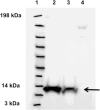Expression and purification of MERS-CoV envelope protein, an essential viroporin, using the baculovirus expression system
- PMID: 37069902
- PMCID: PMC10105271
- DOI: 10.18502/ijm.v15i1.11926
Expression and purification of MERS-CoV envelope protein, an essential viroporin, using the baculovirus expression system
Abstract
Background and objectives: The causative agent of Middle East Respiratory Syndrome (MERS) is a zoonotic Coronavirus (MERS-CoV) identified in Saudi Arabia in 2012. The envelope (E) protein of MERS-CoV is a small viral protein which plays several essential roles during virus replication. To facilitate study of the structure and function of the E protein, recombinant MERS-CoV E protein was expressed using the baculovirus expression system.
Materials and methods: A recombinant E open reading frame including an 8-histidine tag at the amino terminus was designed and cloned into a baculovirus transfer vector. Following construction of a recombinant virus insect cells were infected and the expression of the E protein assessed by SDS-PAGE and Western blotting.
Results: Recombinant E protein, tagged at the N-terminus with a polyhistidine sequence, with a molecular mass of 10.18 kD was identified by Western blotting with an anti-His antibody. Following large scale infection E protein was released by detergent mediated lysis of infected cells and purified by Immobilized Metal Ion Affinity Chromatography (IMAC).
Conclusion: Purified full length recombinant MERS-CoV E protein can be isolated by IMAC and is suitable for further functional, biophysical or immunological studies.
Keywords: Baculovirus; Coronaviruses; Envelope protein; Immobilised metal-affinity chromatography; Insect cells; MERS-CoV; Middle east respiratory syndrome.
Copyright © 2023 The Authors. Published by Tehran University of Medical Sciences.
Figures





Similar articles
-
Preparation of virus-like particle mimetic nanovesicles displaying the S protein of Middle East respiratory syndrome coronavirus using insect cells.J Biotechnol. 2019 Dec 20;306:177-184. doi: 10.1016/j.jbiotec.2019.10.007. Epub 2019 Oct 12. J Biotechnol. 2019. PMID: 31614169 Free PMC article.
-
MERS-CoV: epidemiology, molecular dynamics, therapeutics, and future challenges.Ann Clin Microbiol Antimicrob. 2021 Jan 18;20(1):8. doi: 10.1186/s12941-020-00414-7. Ann Clin Microbiol Antimicrob. 2021. PMID: 33461573 Free PMC article. Review.
-
Tropism and replication of Middle East respiratory syndrome coronavirus from dromedary camels in the human respiratory tract: an in-vitro and ex-vivo study.Lancet Respir Med. 2014 Oct;2(10):813-22. doi: 10.1016/S2213-2600(14)70158-4. Epub 2014 Aug 28. Lancet Respir Med. 2014. PMID: 25174549 Free PMC article.
-
Middle East respiratory syndrome coronavirus quasispecies that include homologues of human isolates revealed through whole-genome analysis and virus cultured from dromedary camels in Saudi Arabia.mBio. 2014 Apr 29;5(3):e01146-14. doi: 10.1128/mBio.01146-14. mBio. 2014. PMID: 24781747 Free PMC article.
-
Comparative analysis of the genome structure and organization of the Middle East respiratory syndrome coronavirus (MERS-CoV) 2012 to 2019 revealing evidence for virus strain barcoding, zoonotic transmission, and selection pressure.Rev Med Virol. 2021 Jan;31(1):1-12. doi: 10.1002/rmv.2150. Epub 2020 Aug 17. Rev Med Virol. 2021. PMID: 32803835 Free PMC article. Review.
Cited by
-
Advancements in the application and research of baculovirus vector vaccines for respiratory diseases in human.Front Microbiol. 2025 Mar 13;16:1558482. doi: 10.3389/fmicb.2025.1558482. eCollection 2025. Front Microbiol. 2025. PMID: 40182293 Free PMC article. Review.
References
LinkOut - more resources
Full Text Sources
